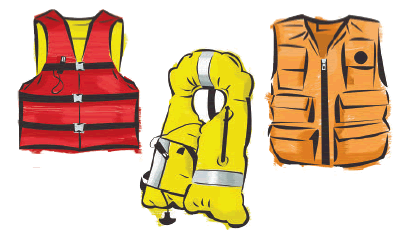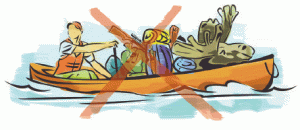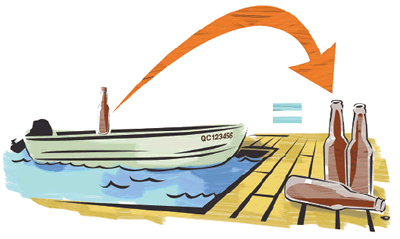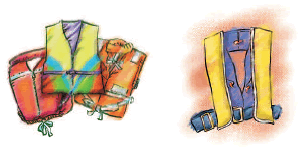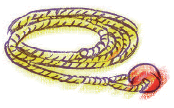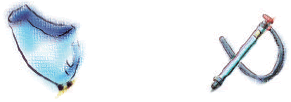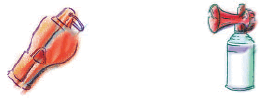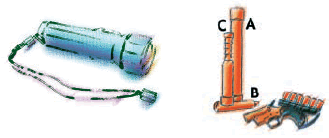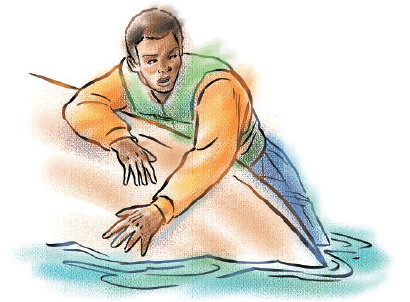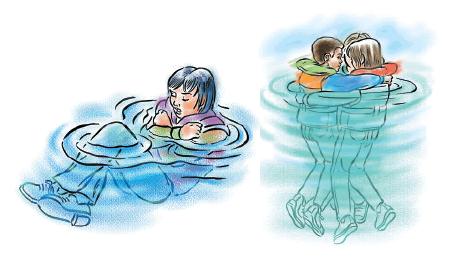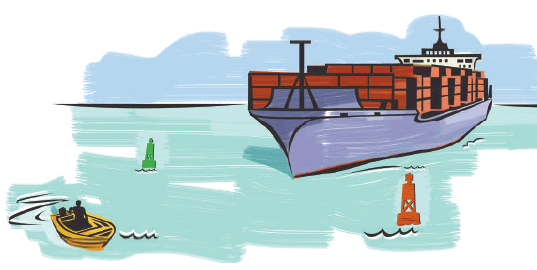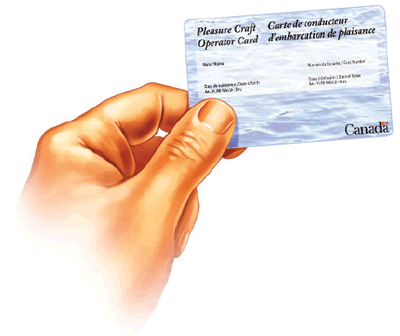TP 14659 - Passport for Anglers and Hunters
(PDF, 2.1 MB)
On this page
- Introduction
- The ABCs of flotation devices
- Overloading and stability
- Alcohol consumption
- Mandatory safety equipment
- Hypothermia and survival in cold water
- Pre-departure checklist
- Sail plan
- The importance of proper training
Introduction
Each year an alarming number of hunters and anglers taking part in water activities unnecessarily lose their lives due to negligence and a lack of knowledge of water safety rules. This “passport” will help you prepare for a safe and enjoyable fishing and hunting excursion. Consider this “passport” a part of your safety equipment and keep it on board.
The ABCs of flotation devices
A large number of sport hunters and anglers die each year simply because they either neglected to wear their flotation devices or wore them improperly. More alarming still is that the majority of these had the lifesaving devices on board their craft.
The regulation requires that each craft (regardless of the type of craft) have on board a Canadian-approved personal flotation device or lifejacket, of the appropriate size, for each individual on board.
Standards of approval
To comply with the standards, you must ensure that the label inside the flotation device indicates that it has been approved by one of the following agencies:
- Transport Canada
- Fisheries and Oceans Canada
- Canadian Coast Guard
Different styles
Today you can choose from a wide range of personal flotation devices (PFDs) offered in a variety of different colours and styles. Hunters and anglers can now find PFDs designed specifically for their activity.
Certain types have greater room in the arms to permit aiming for hunters, or freer casting for fly fishers. Some are available in camouflage. Others offer compartments for storing fishing tackle and accessories (flies, lures, etc. ). Another style, which is light, comfortable and less bulky, is the inflatable type. (This one must be worn at all times to comply with standards.)
It is important to note that the most highly visible colours in the water are red, orange and yellow. Wearing these colours increases your chances of being located during a search and rescue operation.
Popular misconception
It is incorrect to assume that it would be possible to easily locate and put on a flotation device once you have fallen into the water, even if you are a good swimmer. The following are examples of why:
- Wind and waves may make the task very difficult;
- Cold water temperatures may paralyze you;
- The flotation device itself may remain in the boat, away from your reach.
Tip
Make sure you shop around for a flotation device that is appropriate for you. Ensure that the style you choose fits you comfortably and wear it at all times on the water. A flotation device, even within arm’s reach, is too far away. Checking the condition of your flotation device and trying it out in the water is strongly recommended.
Overloading and stability
It is extremely dangerous to overload your craft. The most common cause of drowning during recreational boating is capsizing, followed closely by falling overboard. Many precautions may be taken to reduce loss of life:
- Respect the recommended limits indicated on the capacity plate/label regarding the maximum load or number of occupants that the craft can safely carry;
- Ensure even weight distribution of occupants and equipment;
- Maintain the lowest possible centre of gravity within the craft;
- Properly secure equipment to avoid shifting, which could interfere with the craft’s stability and lead to capsizing;
- Ensure you are familiar with your craft’s limitations and handling. Overloading affects stability and causes the craft to be more difficult to manoeuvre;
- Avoid standing in a small craft. If you must move around, keep your centre of gravity (weight) as low as possible.
Maximum load
It is important to note that the maximum load calculation is based on use during fair weather conditions with a well-distributed load.
Reminder
The number of occupants that may be safely transported depends on the type of craft, the weight and distribution of on board equipment and weather conditions.
Alcohol consumption
Did you know?
Drinking one alcoholic beverage aboard a boat is the equivalent to drinking three on land.
The consumption of alcohol in a pleasure craft is much more dangerous than most people realize. Fatigue, sun, wind and the rocking movement of the boat may dull your senses. Alcohol intensifies this effect, reducing your reaction time, your judgment and, consequently, your ability to navigate your craft.
It is as dangerous and illegal to boat while under the influence of alcohol, as it is to drive a vehicle on land while intoxicated.
Impaired operation of a watercraft is illegal and constitutes an infraction of the Criminal Code of Canada. Anyone operating a watercraft while under the influence of alcohol is committing an infraction that could result in them losing their automobile driver’s license.
Keeping this in mind, wait until the day of fishing or hunting has ended before having a drink. Don’t forget that you are responsible not only for your own safety, but also for the safety of others on board.
Mandatory safety equipment
During each outing, examine the condition of your equipment and ensure that you have all the required safety equipment on board. The minimum requirements are based upon the craft’s length. For a motorized craft no greater than 6 metres (19 feet 8 inches) in length, the following equipment is required:
- An appropriately sized, Canadian-approved personal flotation device (PFD) or lifejacket, for each person on board;
- A buoyant heaving line (15 metres in length);
- Manual propelling device or anchor with at least 15 metres of rope, cable or chain;
- Bailer or hand pump;
- Sound-signalling device;
- Navigation lights if the craft is used between sunset and sunrise or during periods of reduced visibility, i.e. mist and rain;
- A class 5BC fire extinguisher for any craft equipped with an inboard motor, fixed fuel tank, and/or any fuel-burning cooking, heating or refrigeration units;
- A waterproof flashlight or 3 Canadian approved flares (type A, B or C flares);
- A vessel license if your craft is outfitted, even temporarily, with any motor of 10 hp (7.5 kW) or more. Ensure your vessel is properly marked and you carry a copy of the vessel license.
The two last items are not mandatory if your craft is not equipped with a motor (canoe, kayak, etc.).
Did you know?
All requirements apply to you even if you are just renting or borrowing a craft, regardless of its size. The responsibility for possessing required equipment is shared equally by the lessor and lessee.
Remember that the equipment must be in good working order, easily accessible and useable by everyone on board.
Tip
Apart from the required equipment, certain items could be extremely useful in order for you to have a pleasant time on the water. If your trip is for several hours, you should have with you:
- spare clothing in a waterproof bag (weather can change without notice, and it’s best to be prepared);
- drinking water and snacks;
- tools and spare parts (fuses, spark plugs, etc.);
- a first aid kit.
Hypothermia and survival in cold water
Fishing and hunting are activities that generally start early and end late in the boating season. Waters are usually cold during those periods, exposing you and other recreational boaters to hypothermia and cold shock.
Cold shock is probably responsible for more deaths than hypothermia. A sudden exposure to cold waters can instantly paralyze your muscles, leave you breathless, cause you to swallow water and suffocate you within moments of immersion. Should you survive the shock of the cold water, hypothermia is the next imminent danger.
Hypothermia is a drop of body temperature below normal (37° C) that results from a prolonged exposure to frigid waters. The signs and symptoms of the three different stages of hypothermia are:
- First stage: shivering, reduced circulation;
- Second stage: slow, weak pulse, slowed breathing, lack of co-ordination, irritability, confusion and sleepy behaviour;
- Advanced stage: slow, weak or absent respiration and pulse. The person may lose consciousness.
Should you find yourself in the water it is essential to do everything possible to conserve your energy and body heat. To lengthen your survival time, the following is important:
- Wear your personal flotation device (PFD) or lifejacket. This will help you to stay afloat and keep your head out of the water without wasting your energy;
- Swim only if you can join others or reach a safe shelter. Do not swim to keep yourself warm, this will only increase your loss of body heat;
- If possible, climb on top of a floating object (such as your craft) to keep as much of your body as possible out of the water. Frigid water will lower your body temperature faster than air (25 times faster);
- Assume the fetal position, or if you are not alone, huddle together;
- Remove the wet clothing of anyone who has fallen into the water and warm him or her with dry clothes.
Popular misconception
Contrary to popular belief, alcohol does not warm you up but, rather, has the opposite effect. It is preferable to drink a warm, sugared, non-alcoholic drink that is free of caffeine.
Tip
Wear layered clothing under a windbreaker rather than one thick layer. Wool, even when wet, retains more heat than synthetics (polyester).
Pre-departure checklist
Before setting out, it is important to verify certain elements to ensure the safety of all aboard:
- Be aware of the weather forecast and of all local hazards;
- Always inform a responsible person of your destination, the time of your expected return and a description of your craft;
- Check your fuel supply;
Did you know?
A good rule of thumb regarding fuel is to ration one-third for the trip out, one-third for the return and one-third as reserve.
- Whether you own or plan to rent or borrow a watercraft, always ensure that it is in good working order and well equipped;
- Have on board all required safety gear, ensuring that it is in good working order;
- Make sure that the load is well distributed in the craft;
- Bring along a communication device to call for help should you need it; and
- Always ensure that the drain plug is properly secured before launching your boat.
Need help?
In case of emergency, it is important to know how to send distress signals and ask for help; it could mean the difference between life and death:
- On waters serviced by the Coast Guard, the VHF marine radio is generally the most effective way to broadcast your distress. Use channel 16 and repeat “Mayday” three times;
- A cellular phone is also a means of asking for help. Turn to page 27 of this guide for a list of Marine and Air Search and Rescue Emergency Telephone Numbers. Some cellular providers also offer the *16 service to reach the Coast Guard. Should you find yourself in need of assistance on waters not serviced by the Coast Guard, call the police by dialling 911;
- If you are planning a longer excursion of several days, you may wish to consider obtaining a satellite phone or an Emergency Position Indicating Radio Beacon (EPIRB), which transmits a coded signal used only in times of distress. On activation of the EPIRB signal, Canadian search and rescue resources are deployed to your rescue.
Did you know?
To function properly, the Emergency Position Indicating Radio Beacon must be registered with the Canadian Beacon Registry by calling 1-800-727-9414.
Sail plan
Whether leaving for a few hours or several days, a sail plan remains one of your most important lifesaving tools.
The sail plan holds information on the route you plan to take as well as details about your watercraft and the people accompanying you on board.
It is important to always leave a sail plan with a responsible person before setting out. The person should be advised to alert the appropriate authorities (Coast Guard or police) in the event that you fail to return on schedule, so that they may come to your rescue.
When undertaking a long trip it is recommended to report your location daily.
Important
Always let the person you entrusted with your sail plan know of your return to avoid unnecessarily deploying a search.
Navigating in commercial shipping channels
- Respect right-of-way rules and keep clear of the path of larger vessels;
- Do not obstruct the channel; for example, never moor to a navigational buoy;
- Be seen. A radar reflector helps larger, less manoeuvrable vessels detect your presence on their radar screens;
- Have on board the marine charts for the region you are navigating.
The importance of proper training
Whether you own, rent or borrow a pleasure craft, there are rules and information that you must know before setting out. Furthermore, you have the same responsibilities as other boaters (pleasure craft or personal watercraft operators).
Important
If you are loaning your boat, ensure that the operator knows the existing Canadian regulations and safety measures to follow. Take the time to ensure proper familiarization with the boat’s handling and that he or she holds any required competency cards.
According to the Competency of Operators of Pleasure Craft Regulations, all operators of a motorized pleasure craft, on all Canadian waterways, must obtain proof of competency for navigating the craft before 2009. This is already mandatory for any person born after April 1, 1983, and for those navigating crafts of less than 4 metres (13 feet 1 inch) of length. All other boaters must obtain certification before September 15, 2009.
The best way to obtain proof of competency is to take a course and to successfully complete an accredited boat safety test. Learning proper navigational techniques and becoming well acquainted with existing regulations will allow you to use your pleasure craft safely and fully enjoy your preferred sport.
Did you know?
Occasional users wishing to lease a motorized craft must obtain temporary proof of competency with each rental by co-signing a rental boat safety checklist with the lessor before setting out. This allows the operator to be familiar with the proper functioning of the craft, the geographic characteristics and any hazards that might be present in the area, as well as boating safety rules.
The operator must have on board a copy of the verification list signed by both parties as proof of competency.
Marine and air search and rescue emergency telephone numbers
Act smart and call early in an emergency. The sooner your call, the sooner help will arrive.
Pacific Coast
Joint Rescue Coordination Centre
Victoria
1-800-567-5111 or 1-250-363-2333
Great Lakes and Arctic
Joint Rescue Coordination Centre
Trenton
1-800-267-7270 or 1-613-965-3870
St. Lawrence River
Maritime Rescue Sub-Centre
Quebec
1-800-463-4393 or 1-418-648-3599
Newfoundland and Labrador Coast
Maritime Rescue Sub-Centre
St. John’s
1-800-563-2444 or 1-709-772-5151
Maritimes Coast
Joint Rescue Coordination Centre
Halifax 1-800-565-1582 or 1-902-427-8200
